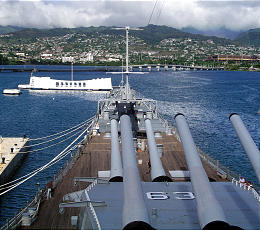Associated Press

PEARL HARBOR, Hawaii — Each day, thousands of people visit the USS Arizona Memorial to pay tribute to the victims of Pearl Harbor. The Japanese sneak attack on Dec. 7, 1941, killed 2,388 Americans, shattered the U.S. Pacific Fleet, and propelled the United States into World War II. A gleaming white memorial straddles the sunken battleship where many of the 1,177 sailors killed that day are still entombed.
For many visitors, paying their respects at the Arizona Memorial is a prelude to touring the Battleship Missouri Memorial. The USS Missouri served in World War II, the Korean War and the Gulf War, and the ship has been turned into a museum about daily life aboard a 20th century war vessel.
Together, the Arizona and Missouri served as bookends for the war. The attack on Pearl Harbor and the Arizona’s destruction forced the United States to enter World War II; the conflict formally ended aboard the Missouri on Sept. 2, 1945, when Japanese leaders signed surrender documents in Tokyo Bay at a ceremony presided over by Gen. Douglas MacArthur.
“We want people to come to the Missouri, but we want them to go to the Arizona first,” says Lee Collins, spokesman for the USS Missouri Memorial Association. “They’re going to cry and then come to the Missouri and get the rest of the story. The experience isn’t as powerful if you don’t have that sense of tragedy.”
Visitors walk under a main battery of gun turrets 65 feet long and each weighing 116 tons, able to hurl 2,700 pound shells 23 miles in 50 seconds with near-pinpoint accuracy, and marvel at the 1,200 foot-long anchor with 110-pound links.
Those who prefer to avoid the group tour can take the self-guided audio tour. It’s informative — 2 1/2 hours of stories and history if you listen to it all — and loaded with technical information. The drawback? Your wanderings are somewhat limited, and of course, you can’t ask questions of the recorder.
There are several alternatives. The Chief’s Tour is $6 and takes an hour, providing just enough interaction before your own explorations begin. But my 10- and 12-year-old children and I opted for the three-hour Explorer’s Tour ($49 adult, $39 child; children under 5 not allowed). We arrived half an hour before our tour was scheduled to begin — necessary because you must park in the public lot and take a trolley across Ford Island Bridge to the battleship — and donned yellow vests and hardhats for our expedition.
My children found it fascinating to delve into shipboard life. They were amazed to find a post office, barbershop, laundry, brig (jail), library and kitchen bowls big enough to bathe in, to cook for thousands.
The communication center revealed the evolution from Morse code during World War II to computers in Desert Storm, as well as the analog computers that controlled the massive guns. The Missouri was modernized in 1986 — after 29 years in mothballs — with the latest technology for use in the Gulf War. New areas of the ship, such as the engine room, will soon be open on some of the tours.
Visitors are encouraged to stamp their special Battleship Passport at stations along the way, such as the Executive Officer’s Cabin and the Surrender Deck. Unfortunately, many of the stamps were dried out or broken, but the problem was solved with a trip to the Victory Shop, where all the stamps were available in a plastic container.
Our tour finished with a snack on the mess deck. After disembarking, I paid an additional $5 so the kids could ride the Air Combat Simulator ride,
next door to the battleship. Although both children emerged with big smiles on their faces, they declared the ride not worth the expense.
Yet we were so thrilled with the tour we didn’t hesitate to spend $20 on a photo and refrigerator magnets of ourselves posed in front of the monolith, dressed in sailor hats and grinning wildly.
Another option for visitors is the Encampment Program, which allows children and adults to spend the night on board, eating on the mess deck and sleeping in the minuscule bunks — also known as “coffin racks.” The program was suspended after the Sept. 11th attacks but has recently been reinstated.
“Just like real sailors, campers sleep in the crew berthing areas, store their gear in the lockers, eat Navy-style meals (such as meatloaf) on the ship’s mess deck, and use shipboard restroom and shower facilities,” says Steven Kooiman, education manager for the USS Missouri Memorial Association.
Check-in begins at 4:30 p.m., then guests gather for duty assignments such as video operations and K.P., lowering and raising the flag, reveille, cleanup and other activities to promote Navy-style camaraderie.
We’re looking forward to returning, because we know we’ll discover something new. The tour guides are informal and friendly, overflowing with anecdotes, zealous about the topic and happy to answer questions. Lee says no two tours are alike; a third or even fourth visit never will be the same.